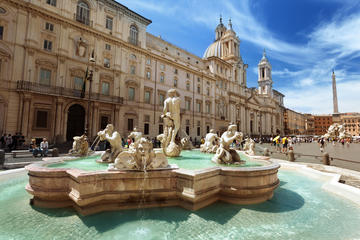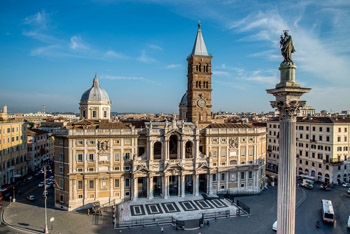
The Gathering Point
by Ron Ellege
What do dancing young people, senior sojourners, and Pope Francis have in common? The Basilica of Santa Maria Maggiore in Rome, Italy.
Viewing its Activity
When in Rome, our go to hotel is the Mecenata Palace which is a worthy refuge of elegance, located atop Esquiline Hill. The hotel is directly across the street from the Basilica, and our requested room provides an unobstructed view of the church.
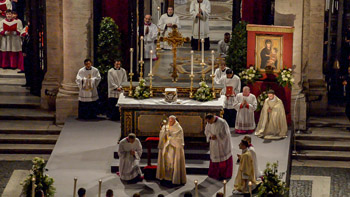 Over the years we have watched groups gather at twilight for the beginning of their pub crawls. Dividing into teams, they guzzle through drinking games in the piazza while preparing for their evening of revelry. We have observed crowds gather for marches, tours, protests and rallies. From blurry eyed, early morning senior groups touring the Basilica, to high-spirited youth groups assembling to sing and dance in the square, this church is a well celebrated gathering point.
Over the years we have watched groups gather at twilight for the beginning of their pub crawls. Dividing into teams, they guzzle through drinking games in the piazza while preparing for their evening of revelry. We have observed crowds gather for marches, tours, protests and rallies. From blurry eyed, early morning senior groups touring the Basilica, to high-spirited youth groups assembling to sing and dance in the square, this church is a well celebrated gathering point.
On June 4, 2015, Pope Francis visited Santa Maria Maggiore to celebrate the annual Solemnity of Corpus Christy. The hotel provides an excellent vantage point for this festival held each year on the Basilica steps. My article and pictures of this assembly can be viewed at, “Pope Francis visits Santa Maria Maggiore.”
Importance and Prestige of this Basilica
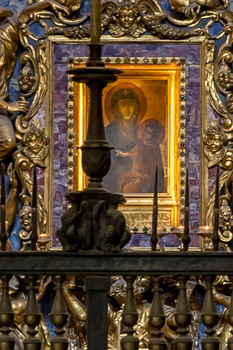 There are over 25 churches in Rome dedicated to Mary, Santa Maria Maggiore is the largest of these Marian churches. This Major Papal Basilica is prominent in the tradition and adulation of the Catholic community worldwide. Many travel blogs rate Santa Maria as one of the ten most beautiful churches in Europe. Walks of Italy tour Major Basilicas of Rome, includes it as one of “the three most important churches in Rome.” Frommer’s rates it #3 in its article; “The Best Churches.” If you are a cathedral buff, Italy is not complete until you have experienced this great lady.
There are over 25 churches in Rome dedicated to Mary, Santa Maria Maggiore is the largest of these Marian churches. This Major Papal Basilica is prominent in the tradition and adulation of the Catholic community worldwide. Many travel blogs rate Santa Maria as one of the ten most beautiful churches in Europe. Walks of Italy tour Major Basilicas of Rome, includes it as one of “the three most important churches in Rome.” Frommer’s rates it #3 in its article; “The Best Churches.” If you are a cathedral buff, Italy is not complete until you have experienced this great lady.
Located on Esquiline Hill, one of the ancient “Seven Hills of Rome,” the present Basilica dates back to the fifth century AD. It was constructed between 432 and 440 to celebrate the major output of the 431 Council of Ephesus. In Catholic tradition, the Basilica is an attestation of the importance of the Virgin Mary as the Mother of God.
This Basilica is Rome’s only remaining example of early Christian architecture whose core structure remains as it was 1600 years ago. Step in the door and wonder surrounds you, grand and modest – simple yet extravagant, art which captures the eye is witnessed in every direction. The mosaics found in Santa Maria Maggiore are among the oldest representations of the Virgin Mary in Christian Antiquity. Revelations of human thought, presented through combinations of differing styles of mosaic expression.
The Nave and Triumphal Arch
 The golden mosaics adorning the triumphal arch date from the 5th century and depict scenes from the early life of Christ and the Virgin Mary. On the left at the top is a panel depicting Christ’s enthronement with a group of angels as his court. Below this is the Epiphany or Adoration of the Magi. The young Christ is seated on a throne with Mary on his right, they are attended by angels.
The golden mosaics adorning the triumphal arch date from the 5th century and depict scenes from the early life of Christ and the Virgin Mary. On the left at the top is a panel depicting Christ’s enthronement with a group of angels as his court. Below this is the Epiphany or Adoration of the Magi. The young Christ is seated on a throne with Mary on his right, they are attended by angels.
Panels on the Right side of the triumphal arch include the Presentation in the Temple; the Flight into Egypt; Herod visited by the Magi; the city of Bethlehem. The top center panel displays a circle containing the apocalyptic throne of Christ with the Book of the Seven Seals, flanked by St. Peter and St. Paul.
The Apse
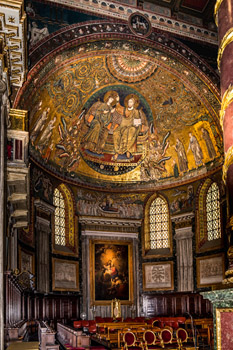 Italian painter and mosaic maker Jacopo Torriti is credited with the adornment of the apse, he crafted it in 1295. The magnificent central work shows the Coronation of the Virgin in which Jesus and Mary are seated on a throne with Jesus placing a jeweled crown on Mary’s head. The sun and moon are under their feet accompanied by a choir of adoring angels. Standing to their left are St. Peter, St. Paul, St. Francis of Assisi and Pope Nicholas IV. Standing on the right is St. John the Baptist, St. John the Evangelist, St. Anthony and Cardinal Colonna. The apse of Santa Maria Maggiore is the most important surviving example of Roman mosaic art from the late middle ages. Descend below the high altar and you enter the burial place of Saint Jerome, this 4th-century saint translated the Bible into the Latin language (the Vulgate). Upstairs, located in the Borghese Chapel, is “Salus Populi Romani,” believed to be the oldest Marian image in Rome. However, on display in this vault is arguably the most important artifact of the Basilica, The Reliquary of the Holy Crib. This crystal shrine, designed by Giuseppe Valadier, is said to contain wood from the Holy Crib of the nativity of Jesus Christ.
Italian painter and mosaic maker Jacopo Torriti is credited with the adornment of the apse, he crafted it in 1295. The magnificent central work shows the Coronation of the Virgin in which Jesus and Mary are seated on a throne with Jesus placing a jeweled crown on Mary’s head. The sun and moon are under their feet accompanied by a choir of adoring angels. Standing to their left are St. Peter, St. Paul, St. Francis of Assisi and Pope Nicholas IV. Standing on the right is St. John the Baptist, St. John the Evangelist, St. Anthony and Cardinal Colonna. The apse of Santa Maria Maggiore is the most important surviving example of Roman mosaic art from the late middle ages. Descend below the high altar and you enter the burial place of Saint Jerome, this 4th-century saint translated the Bible into the Latin language (the Vulgate). Upstairs, located in the Borghese Chapel, is “Salus Populi Romani,” believed to be the oldest Marian image in Rome. However, on display in this vault is arguably the most important artifact of the Basilica, The Reliquary of the Holy Crib. This crystal shrine, designed by Giuseppe Valadier, is said to contain wood from the Holy Crib of the nativity of Jesus Christ.
The Legend of the Snowfall
 Legend has it that an aristocrat named Giovanni, and his barren wife were without child. Seeking divine intervention they committed to build a church to the Virgin Mary. She appeared to them in a dream on the night of August 4, 352 A.D. and told them that a miracle would show them the location on which they were to build the church. That night, Pope Liberius was troubled by the same dream. On the following morning, he travelled to Esquiline Hill and found it miraculously covered in snow. Liberius then traced an outline for the location of the planned church. Although many feel this legend has little basis in fact, to this day the church on Esquiline Hill is often referred to as Our Lady of the Snow.
Legend has it that an aristocrat named Giovanni, and his barren wife were without child. Seeking divine intervention they committed to build a church to the Virgin Mary. She appeared to them in a dream on the night of August 4, 352 A.D. and told them that a miracle would show them the location on which they were to build the church. That night, Pope Liberius was troubled by the same dream. On the following morning, he travelled to Esquiline Hill and found it miraculously covered in snow. Liberius then traced an outline for the location of the planned church. Although many feel this legend has little basis in fact, to this day the church on Esquiline Hill is often referred to as Our Lady of the Snow.
 5 Reasons to visit Santa Maria Maggiore
5 Reasons to visit Santa Maria Maggiore
1. The opulence of its décor.
♦ This gem will keep your camera snapping and your eyes twinkling from the grandeur of its marble floors, tapestries, mosaics, statues, tombs and relics.
♦ Its spectacular ceiling is said to be decorated with gold which Columbus transported from the new world.
2. The freedom to move about with little crowding
♦ Check the schedule for special occasions and visit any other time.
♦ Only on rare occasions is this venue crowded.
3. Proximity and ease of access
♦ A four block walk from the main train station and Termini Underground.
♦ The city bus stop is on the corner of the piazza
♦ A scheduled stop for all Hop On Hop Off tours
♦ Only a ten minute walk from the Colosseum.
4. It’s FREE! There is no cost of admission
♦ Stay as long as you want, return as often as you please.
5. Its prominence and status among Rome’s churches
♦ Santa Maria Maggiore is one of the Seven Pilgrim Churches of Rome
♦ It stands among the four patriarchal basilicas
Maria Maggiore is listed as a “Top 10 Attraction” and “Must See Venue” in most major guide books, including Rick Steves’.


If You Go:
Expect to spend several hours in this grand Basilica and by all means, bring a camera. Guided tours can be arranged through many of the local or world-wide guide services such as Frommer’s or Walks of Italy. Self-guided tours, complete with audio guides are available in the vestibule. For information visit their official website.
Hours of Operation: The Santa Maria Maggiore Basilica is open Monday through Saturday from 7:00 to 19:00 (in winter until 18:00), on Sundays and holidays from 9:30 to 12:00. Free admission.
How to get there: get off at the stop termini of the underground; take via Cavour southwest 4 blocks, the Basilica is on your left. The Basilica is located on the square with the same name – Piazza di Santa Maria Maggiore also referred to as Piazza dell’Esquilino.
Address: Piazza di S. Maria Maggiore, 42, 00100 Roma RM, Italy
Phone: +39 06 6988 6800
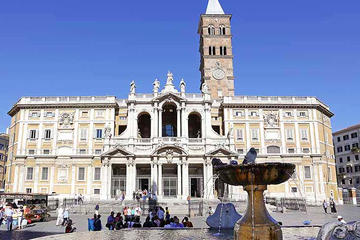
Churches of Rome Small-Group Tour: Maria Maggiore, Santa Pudenziana, and Basilica di Santa Prassede
About the author:
Ron Elledge is a Freelance Writer/Photographer. You can see some of his work at these sites:
www.writtenfyi.com (blog)
www.ronelledgeexposed.com (photography)
ron@writtenfyi.com (email)
All photos are by Ron Elledge.

 5 Reasons to visit Santa Maria Maggiore
5 Reasons to visit Santa Maria Maggiore
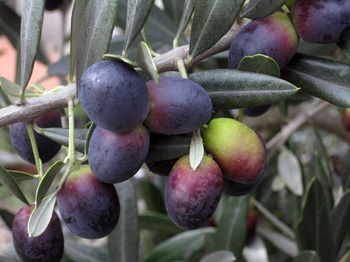
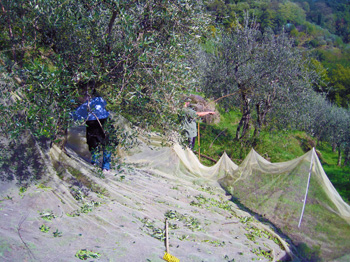 To create the highest quality olive oil, it is vital to time the harvest perfectly. Unlike in other regions, olives in Tuscany are picked before they are ready to fall from the tree. This produces a fruity and lean extra virgin olive oil, even if the yield is lower. The ideal time to harvest is when the unripe green olives begin to mature and turn black, which is when they contain the highest quality oil. However, this is easier said than done since even olives on the same tree may mature at different rates. The flavours of green and black olives vary but both are needed to make good quality oil. The initial oil is generally more bitter but olives that fall when too ripe make poorer quality oil. Plucked directly from the tree, the fruit is extremely bitter and almost inedible.
To create the highest quality olive oil, it is vital to time the harvest perfectly. Unlike in other regions, olives in Tuscany are picked before they are ready to fall from the tree. This produces a fruity and lean extra virgin olive oil, even if the yield is lower. The ideal time to harvest is when the unripe green olives begin to mature and turn black, which is when they contain the highest quality oil. However, this is easier said than done since even olives on the same tree may mature at different rates. The flavours of green and black olives vary but both are needed to make good quality oil. The initial oil is generally more bitter but olives that fall when too ripe make poorer quality oil. Plucked directly from the tree, the fruit is extremely bitter and almost inedible.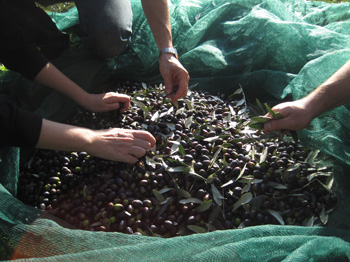 The ideal olive picking team consists of as many family members and friends as possible to share the labour. Firstly, huge nets are spread out around the trunk of a tree. Naturally, most olive groves are far from flat so the nets often have to be propped up by sticks or branches pruned from the trees to prevent the precious harvest from rolling away.
The ideal olive picking team consists of as many family members and friends as possible to share the labour. Firstly, huge nets are spread out around the trunk of a tree. Naturally, most olive groves are far from flat so the nets often have to be propped up by sticks or branches pruned from the trees to prevent the precious harvest from rolling away.
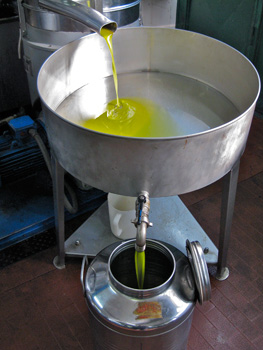 Although very light, the nets are rather cumbersome to move around and harvesters often have to stand in uncomfortable positions on steep slopes. It is essential to gather the harvest before the weather becomes too cold, so work needs to take place, rain or shine. It is also essential not to crush the olives that have fallen onto the nets so you need to be careful where you put your feet.
Although very light, the nets are rather cumbersome to move around and harvesters often have to stand in uncomfortable positions on steep slopes. It is essential to gather the harvest before the weather becomes too cold, so work needs to take place, rain or shine. It is also essential not to crush the olives that have fallen onto the nets so you need to be careful where you put your feet.
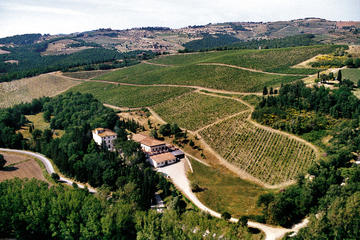

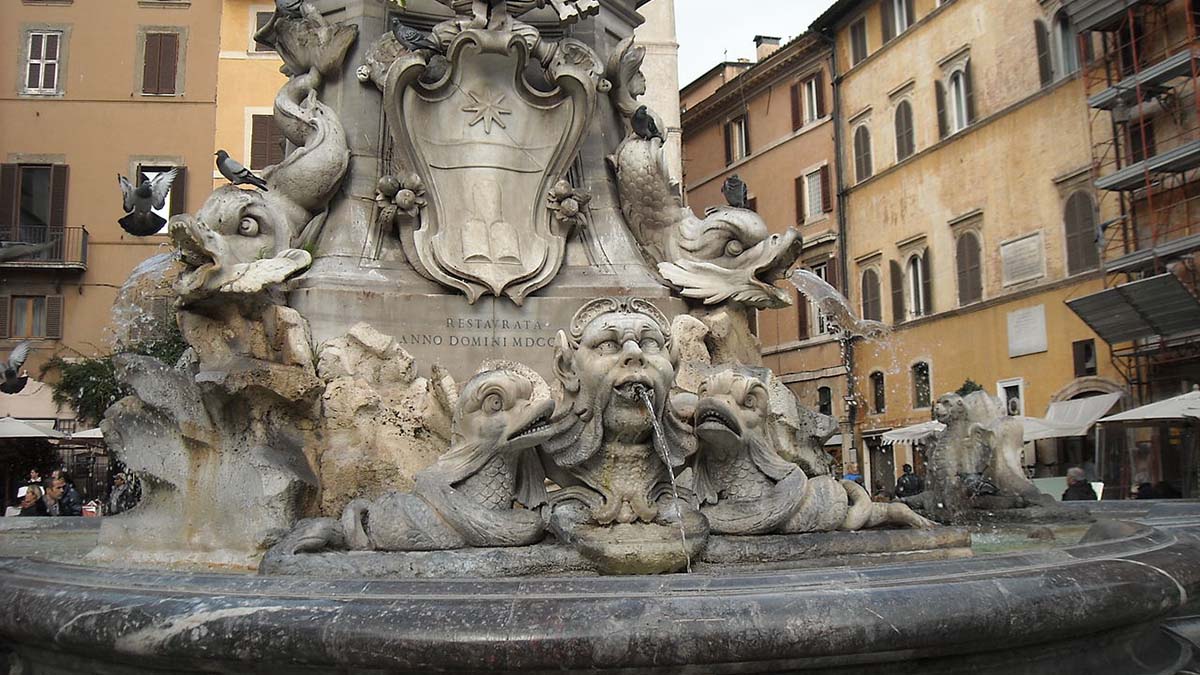
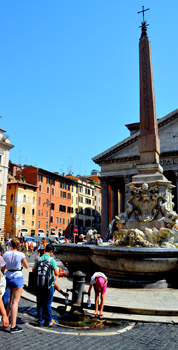 My husband and I arrived in Rome during the heat wave that broke records all across Europe in the summer of 2015. After a week of sweltering in temperatures up to 36.7 (99.68 F) in London and 39.7 C (103 F) in Paris, we were resigned to buying bottled water at every possible opportunity. We were about to learn that Rome is actually better prepared to handle thirsty tourists than most major cities, and that it has been for centuries.
My husband and I arrived in Rome during the heat wave that broke records all across Europe in the summer of 2015. After a week of sweltering in temperatures up to 36.7 (99.68 F) in London and 39.7 C (103 F) in Paris, we were resigned to buying bottled water at every possible opportunity. We were about to learn that Rome is actually better prepared to handle thirsty tourists than most major cities, and that it has been for centuries.
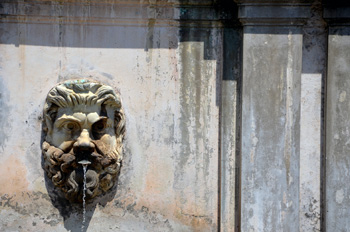 The apparent wastefulness of all that water flowing 24/7 isn’t lost on the city. During the 1980s the city added taps to the fountains, requiring that thirsty Romans operate a nob or button in order to drink. The results were far from satisfying. On hot days, water standing in the pipes heated up, making it less than appealing. Vandals broke the new taps, freeing the flow of the water, and officials gave up on the project. The water doesn’t go entirely to waste. It’s recycled to grow gardens, flush sewers and in industrial cleaning.
The apparent wastefulness of all that water flowing 24/7 isn’t lost on the city. During the 1980s the city added taps to the fountains, requiring that thirsty Romans operate a nob or button in order to drink. The results were far from satisfying. On hot days, water standing in the pipes heated up, making it less than appealing. Vandals broke the new taps, freeing the flow of the water, and officials gave up on the project. The water doesn’t go entirely to waste. It’s recycled to grow gardens, flush sewers and in industrial cleaning.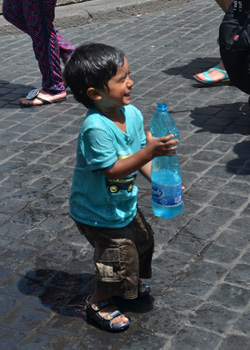 I found one that wasn’t in use on a side street as my husband and I walked back to our hotel from Trevi Fountain on a very hot afternoon. I wondered for a second if it was functional, but as I stepped around it I found a stream of fresh cool water splashing into a grate at my feet. I splashed my face and filled my bottle. By the time I was done, a couple of people had queued up behind me. I felt as much like a native as a brief visitor can feel.
I found one that wasn’t in use on a side street as my husband and I walked back to our hotel from Trevi Fountain on a very hot afternoon. I wondered for a second if it was functional, but as I stepped around it I found a stream of fresh cool water splashing into a grate at my feet. I splashed my face and filled my bottle. By the time I was done, a couple of people had queued up behind me. I felt as much like a native as a brief visitor can feel. Do give the nasoni of Rome a try while you’re there. Your first time may feel a bit daunting, but once you try it, I’ll bet you’re sold on this delicious free resource.
Do give the nasoni of Rome a try while you’re there. Your first time may feel a bit daunting, but once you try it, I’ll bet you’re sold on this delicious free resource.

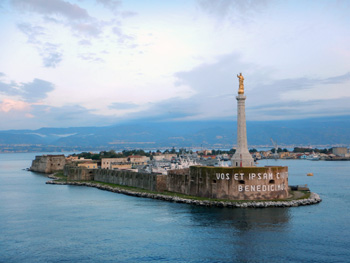
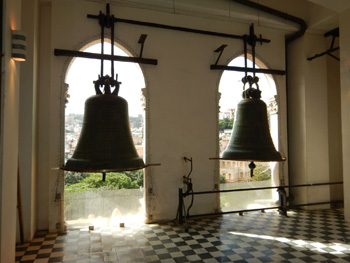 I visit the gift shop to buy postcards and ask questions. The friendly shop keeper is happy to oblige a curious Canadian. She explains that the words under the Madonna at the entrance of the port translate into – “We bless you and the city.” It is believed that this message had been written in a letter to the people of Messina by the Virgin Mary when they converted to Christianity in 42 AD, after a visit from the apostle Paul. This explains why she is called Madonna della Lettera or Madonna of the Letter. I purchase a ticket for five euros to visit the museum and attached clock tower.
I visit the gift shop to buy postcards and ask questions. The friendly shop keeper is happy to oblige a curious Canadian. She explains that the words under the Madonna at the entrance of the port translate into – “We bless you and the city.” It is believed that this message had been written in a letter to the people of Messina by the Virgin Mary when they converted to Christianity in 42 AD, after a visit from the apostle Paul. This explains why she is called Madonna della Lettera or Madonna of the Letter. I purchase a ticket for five euros to visit the museum and attached clock tower.
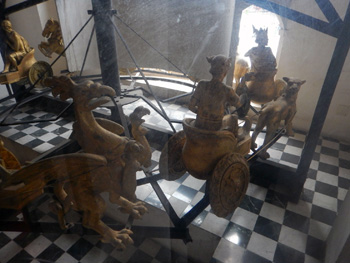 I venture next door to climb the 236 steps to the top of the bell tower. It is worth every step. This belfry houses the largest and most complex mechanical and astronomical clock in the world. On the landings I am able to view, from the inside, the amazing mechanically animated bronze images that rotate on the façade of the tower at the stroke of noon. At the top levels hang the massive bells that ring out the time. I am fortunate I timed my visit between the ringing of the bells. Once at the top, I am rewarded with a splendid view of the city from all four directions. The rain has stopped and the sun is out in full force. I feel I am in heaven, or close to it. I take my time descending, in order to have a better look at the intricate figures, aided by explanations on boards in English as well as Italian. The carousel of life, composed of four golden life size figures representing childhood, youth, maturity and old age, has death in the form of a skeleton following behind. Biblical scenes are depicted on other carousels and changed according to the liturgical calendar. One scene is dedicated to the Madonna of the Letter, where an angel brings the letter to the Virgin Mary followed by St. Paul and the ambassadors who bow when passing in front of the virgin.
I venture next door to climb the 236 steps to the top of the bell tower. It is worth every step. This belfry houses the largest and most complex mechanical and astronomical clock in the world. On the landings I am able to view, from the inside, the amazing mechanically animated bronze images that rotate on the façade of the tower at the stroke of noon. At the top levels hang the massive bells that ring out the time. I am fortunate I timed my visit between the ringing of the bells. Once at the top, I am rewarded with a splendid view of the city from all four directions. The rain has stopped and the sun is out in full force. I feel I am in heaven, or close to it. I take my time descending, in order to have a better look at the intricate figures, aided by explanations on boards in English as well as Italian. The carousel of life, composed of four golden life size figures representing childhood, youth, maturity and old age, has death in the form of a skeleton following behind. Biblical scenes are depicted on other carousels and changed according to the liturgical calendar. One scene is dedicated to the Madonna of the Letter, where an angel brings the letter to the Virgin Mary followed by St. Paul and the ambassadors who bow when passing in front of the virgin.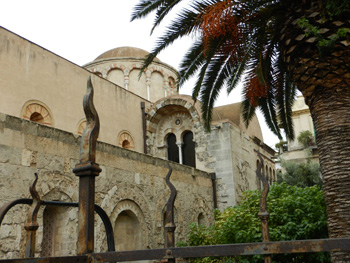 The vibrant plaza in front of the cathedral holds the gorgeous Fountain of Orion. A great place to view the clock tower from the outside and watch it come to life, should you be there at noon. I remove my raincoat and wander the streets. I find an iron worker creating figures in front of his shop called Hollywood. Many sculptures are scattered throughout the town including an imposing conquistador. The picturesque Church of the Catalans, built before Norman times on a pagan site dedicated to the god Neptune, provides different views from each side. A quote from Shakespeare catches my eye, “I learn in this letter that Don Pedro of Arragon comes this night to Messina… He hath an uncle in Messina will be much glad of it.” from Much Ado About Nothing.
The vibrant plaza in front of the cathedral holds the gorgeous Fountain of Orion. A great place to view the clock tower from the outside and watch it come to life, should you be there at noon. I remove my raincoat and wander the streets. I find an iron worker creating figures in front of his shop called Hollywood. Many sculptures are scattered throughout the town including an imposing conquistador. The picturesque Church of the Catalans, built before Norman times on a pagan site dedicated to the god Neptune, provides different views from each side. A quote from Shakespeare catches my eye, “I learn in this letter that Don Pedro of Arragon comes this night to Messina… He hath an uncle in Messina will be much glad of it.” from Much Ado About Nothing. Messina has always been the main portal to Sicily. Founded by the Greeks in the eighth century BC, the influence of Romans, Byzantines, Arabs, Normans and Swabians, who have landed on these shores over the years, contributes to the rich culture.
Messina has always been the main portal to Sicily. Founded by the Greeks in the eighth century BC, the influence of Romans, Byzantines, Arabs, Normans and Swabians, who have landed on these shores over the years, contributes to the rich culture.
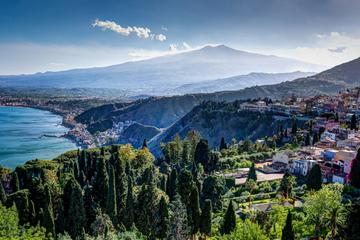
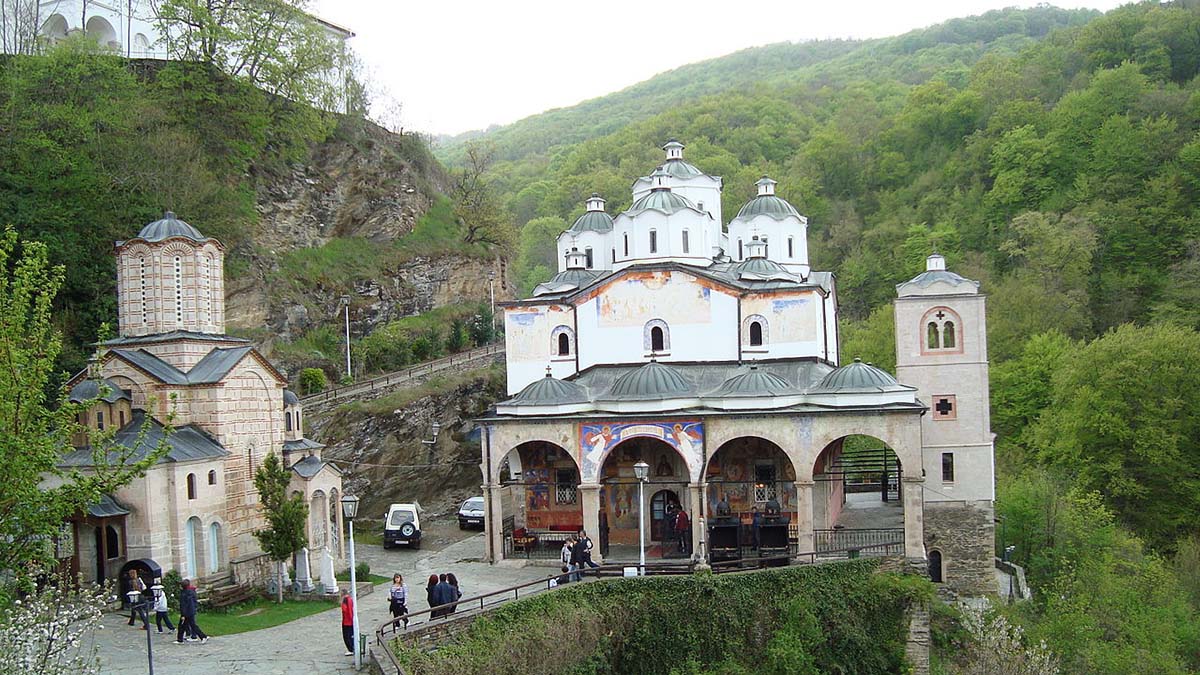
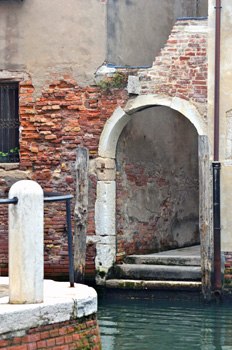 The heavy wooden door closed and I stood surrounded by silence. Flying anywhere from Australia takes a long time, and after a night and a day and a night I was exhausted. Tired and befuddled, I emerged into the chaos of Rome. I finally found a taxi, with a driver who careened down tiny streets where footpaths were more a suggestion than reality.
The heavy wooden door closed and I stood surrounded by silence. Flying anywhere from Australia takes a long time, and after a night and a day and a night I was exhausted. Tired and befuddled, I emerged into the chaos of Rome. I finally found a taxi, with a driver who careened down tiny streets where footpaths were more a suggestion than reality.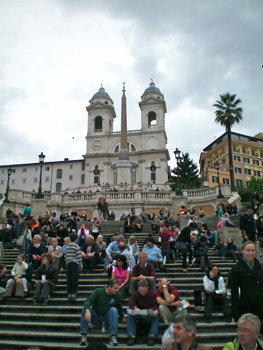 Rooms may be simple, but this does not imply austerity. Convents and monasteries are often to be found in Renaissance palazzos, Medieval walled towns or set amongst lavender fields and vineyards. Many hide artistic treasures; a painting by Rubens, or walls adorned by Fra Angelico. Each religious house has its own character, such as the monastery Convento Sant’Agostino in San Gimigiano which refused entry to HRH The Prince of Wales when he arrived after closing time. (Although probably apocryphal, the story alone makes the place worth a detour.)
Rooms may be simple, but this does not imply austerity. Convents and monasteries are often to be found in Renaissance palazzos, Medieval walled towns or set amongst lavender fields and vineyards. Many hide artistic treasures; a painting by Rubens, or walls adorned by Fra Angelico. Each religious house has its own character, such as the monastery Convento Sant’Agostino in San Gimigiano which refused entry to HRH The Prince of Wales when he arrived after closing time. (Although probably apocryphal, the story alone makes the place worth a detour.)
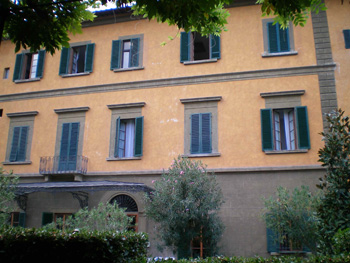 In Florence, the Casa Santo Nome di Jesu is in a 15th C palazzo. I reached my room via a marble staircase, complete with trompe l’oil ceiling of putti and plaster relief. The window overlooked a large garden, complete with kiwi fruit, persimmons, pomegranates, grape vines and wisterias, with trunks as thick as my body. The arbour was a perfect place to sit and pass the afternoon when exhausted by sightseeing.
In Florence, the Casa Santo Nome di Jesu is in a 15th C palazzo. I reached my room via a marble staircase, complete with trompe l’oil ceiling of putti and plaster relief. The window overlooked a large garden, complete with kiwi fruit, persimmons, pomegranates, grape vines and wisterias, with trunks as thick as my body. The arbour was a perfect place to sit and pass the afternoon when exhausted by sightseeing.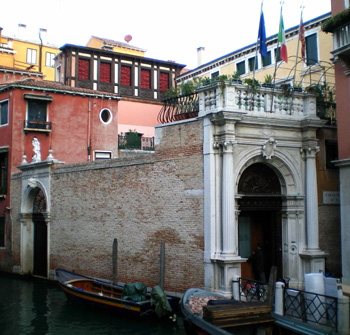 Most convents provide breakfast – fresh rolls and strong coffee are a staple – and often dinner as well. In some, monks still make wine to recipes centuries-old. My first time in Venice, my choice lay at the end of a maze of cobble-stoned side streets and piazzas. The Instituto San Giuseppe stands beside a canal, with a door opening directly onto the water. As I crossed a small limestone bridge a gondola came to a boisterous stop to collect passengers.
Most convents provide breakfast – fresh rolls and strong coffee are a staple – and often dinner as well. In some, monks still make wine to recipes centuries-old. My first time in Venice, my choice lay at the end of a maze of cobble-stoned side streets and piazzas. The Instituto San Giuseppe stands beside a canal, with a door opening directly onto the water. As I crossed a small limestone bridge a gondola came to a boisterous stop to collect passengers.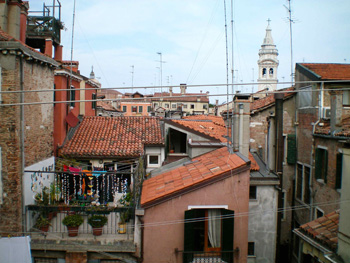 My room was simple and clean. The windows opened onto a terracotta skyline, with clothes strung on a line between two buildings. Across a flower-strewn courtyard a woman in black was busy in her kitchen, filling the air with delicious aromas. Every evening an extended family materialised for dinner. Geraniums hung everywhere in pots. In the distance a camponile tolled away the hours while towering (at a slight angle) over the other buildings,
My room was simple and clean. The windows opened onto a terracotta skyline, with clothes strung on a line between two buildings. Across a flower-strewn courtyard a woman in black was busy in her kitchen, filling the air with delicious aromas. Every evening an extended family materialised for dinner. Geraniums hung everywhere in pots. In the distance a camponile tolled away the hours while towering (at a slight angle) over the other buildings,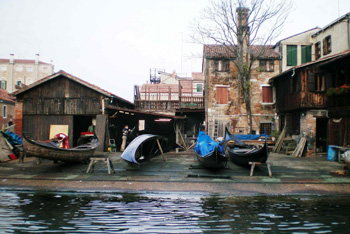 The next essential is catching a boat from the airport to the city, either on the public vaporetto, or by a much faster private boat. Our vessel was all streamlined wood, the skipper as sleek and polished as his vessel. Despite a complete lack of Italian, as soon as my husband began admiring the boat (being a long-time sailor himself) the skipper happily displayed the boat’s paces. As the rain finally poured down and visibility vanished, he raced along the narrow channel to the city, overtaking every other boat in a shower of spray.
The next essential is catching a boat from the airport to the city, either on the public vaporetto, or by a much faster private boat. Our vessel was all streamlined wood, the skipper as sleek and polished as his vessel. Despite a complete lack of Italian, as soon as my husband began admiring the boat (being a long-time sailor himself) the skipper happily displayed the boat’s paces. As the rain finally poured down and visibility vanished, he raced along the narrow channel to the city, overtaking every other boat in a shower of spray.
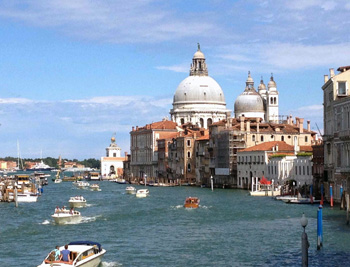 The entrance to the convent Canossian Institute San Trovaso lies on a pretty canal, devoid of tourists. Being in the Dorsoduro area of Venice, the streets are far less crowded than the more popular areas, locals outnumber the tourists, and at night the area is quiet. An elderly nun opened the door, and we walked into tranquility. She led us through an inner courtyard, where some other guests sat sipping wine as their kids feasted on gelato.
The entrance to the convent Canossian Institute San Trovaso lies on a pretty canal, devoid of tourists. Being in the Dorsoduro area of Venice, the streets are far less crowded than the more popular areas, locals outnumber the tourists, and at night the area is quiet. An elderly nun opened the door, and we walked into tranquility. She led us through an inner courtyard, where some other guests sat sipping wine as their kids feasted on gelato.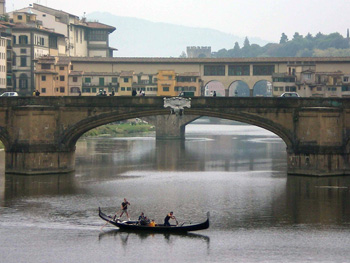 Convents and monastery are not only in cities, but also in idyllic countryside settings. Stays are not restricted to Italy, and some are to be found in the most unexpected of places. An example is the 12th century monastery Kriva Palanka, hidden in the Osogovo Mountains of Macedonia [TOP PHOTO]. It is worth a visit for the medieval frescoes alone.
Convents and monastery are not only in cities, but also in idyllic countryside settings. Stays are not restricted to Italy, and some are to be found in the most unexpected of places. An example is the 12th century monastery Kriva Palanka, hidden in the Osogovo Mountains of Macedonia [TOP PHOTO]. It is worth a visit for the medieval frescoes alone.